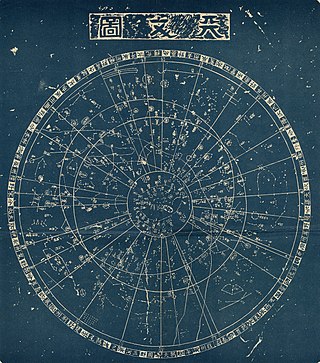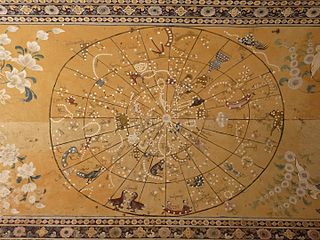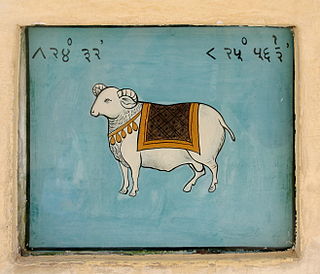Related Research Articles

The zodiac is a belt-shaped region of the sky that extends approximately 8° north and south of the ecliptic, the apparent path of the Sun across the celestial sphere over the course of the year. Also within this zodiac belt appear the Moon and the brightest planets, along their orbital planes. The zodiac is divided along the ecliptic into 12 equal parts ("signs"), each occupying 30° of celestial longitude. These signs roughly correspond to the astronomical constellations with the following modern names: Aries, Taurus, Gemini, Cancer, Leo, Virgo, Libra, Scorpio, Sagittarius, Capricorn, Aquarius, and Pisces.

Traditional Chinese astronomy has a system of dividing the celestial sphere into asterisms or constellations, known as "officials".
A solar calendar is a calendar whose dates indicate the season or almost equivalently the apparent position of the Sun relative to the stars. The Gregorian calendar, widely accepted as a standard in the world, is an example of a solar calendar. The main other types of calendar are lunar calendar and lunisolar calendar, whose months correspond to cycles of Moon phases. The months of the Gregorian calendar do not correspond to cycles of the Moon phase.
Hindu astrology, also called Indian astrology, Jyotisha, Jyotish Shastra, and more recently Vedic astrology, is the traditional Hindu system of astrology. It is one of the six auxiliary disciplines in Hinduism that is connected with the study of the Vedas.
The Hindu calendar, also called Panchanga, is one of various lunisolar calendars that are traditionally used in the Indian subcontinent and Southeast Asia, with further regional variations for social and Hindu religious purposes. They adopt a similar underlying concept for timekeeping based on sidereal year for solar cycle and adjustment of lunar cycles in every three years, but differ in their relative emphasis to moon cycle or the sun cycle and the names of months and when they consider the New Year to start. Of the various regional calendars, the most studied and known Hindu calendars are the Shalivahana Shaka found in the Deccan region of Southern India and the Vikram Samvat (Bikrami) found in Nepal and the North and Central regions of India – both of which emphasize the lunar cycle. Their new year starts in spring. In regions such as Tamil Nadu and Kerala, the solar cycle is emphasized and this is called the Tamil calendar and Malayalam calendar and these have origins in the second half of the 1st millennium CE. A Hindu calendar is sometimes referred to as Panchangam (पञ्चाङ्गम्), which is also known as Panjika in Eastern India.

The Ox is the second of the 12-year periodic sequence (cycle) of animals which appear in the Chinese zodiac related to the Chinese calendar, and also appears in related calendar systems. The Chinese term translated here as ox is in Chinese niú , a word generally referring to cows, bulls, or neutered types of the bovine family, such as common cattle or water buffalo. The zodiacal ox may be construed as male, female, neutered, intersex, and either singular or plural. The Year of the Ox is also denoted by the Earthly Branch symbol chǒu. The term "zodiac" ultimately derives from an Ancient Greek term referring to a "circle of little animals". There are also a yearly month of the ox and a daily hour of the ox. Years of the oxen (cows) are cyclically differentiated by correlation to the Heavenly Stems cycle, resulting in a repeating cycle of five years of the ox/cow, each ox/cow year also being associated with one of the Chinese wǔxíng, also known as the "five elements", or "phases": the "Five Phases" being Fire, Water, Wood, Metal, and Earth. The Year of the Ox follows after the Year of the Rat which happened in 2020 and is then followed by the Year of the Tiger, which happened in 2022.

A panchāngam is a Hindu calendar and almanac, which follows traditional units of Hindu timekeeping, and presents important dates and their calculations in a tabulated form. It is sometimes spelled Panchāngamu, Pancanga, Panchanga, Panchaanga, or Panchānga, and is often pronounced Panchāng. Panchangas are used in Jyotisha.

In Western astrology, astrological signs are the twelve 30-degree sectors that make up Earth's 360-degree orbit around the Sun. The signs enumerate from the first day of spring, known as the First Point of Aries, which is the vernal equinox. The astrological signs are Aries, Taurus, Gemini, Cancer, Leo, Virgo, Libra, Scorpio, Sagittarius, Capricorn, Aquarius, and Pisces. The Western zodiac originated in Babylonian astrology, and was later influenced by the Hellenistic culture. Each sign was named after a constellation the sun annually moved through while crossing the sky. This observation is emphasized in the simplified and popular sun sign astrology. Over the centuries, Western astrology's zodiacal divisions have shifted out of alignment with the constellations they were named after by axial precession of the Earth while Hindu astrology measurements correct for this shifting. Astrology was developed in Chinese and Tibetan cultures as well but these astrologies are not based upon the zodiac but deal with the whole sky.

An astrological age is a time period which, according to astrology, parallels major changes in the development of human society, culture, history, and politics. There are twelve astrological ages corresponding to the twelve zodiacal signs in western astrology. One cycle of the twelve astrological ages is called a Great Year, comprising 25,772 solar years, at the end of which another cycle begins.
Nakshatra is the term for lunar mansion in Hindu astrology. A nakshatra is one of 27 sectors along the ecliptic. Their names are related to a prominent star or asterisms in or near the respective sectors. In essence, a nakshatra simply is a constellation. Every nakshatra is divided into four padas related to the Char Dham, a set of four pilgrimage sites in India.
The star cluster Kṛttikā Sanskrit: कृत्तिका, pronounced, popularly transliterated Krittika), sometimes known as Kārtikā, corresponds to the open star cluster called Pleiades in western astronomy; it is one of the clusters which makes up the constellation Taurus. In Indian astronomy and Jyotiṣa the name literally translates to "the cutters". It is also the name of its goddess-personification, who is a daughter of Daksha and Panchajani, and thus a half-sister to Khyati. Spouse of Kṛttikā is Chandra ("moon"). The six Krittikas who raised the Hindu God Kartikeya are Śiva, Sambhūti, Prīti, Sannati, Anasūya and Kṣamā.

The decans are 36 groups of stars used in the ancient Egyptian astronomy to conveniently divide the 360 degree ecliptic into 36 parts of 10 degrees each, both for theurgical and heliacal horological purposes. The decans each appeared, geocentrically, to rise consecutively on the horizon throughout each daily Earth rotation. The rising of each decan marked the beginning of a new decanal "hour" of the night for the ancient Egyptians, and they were used as a sidereal star clock beginning by at least the 9th or 10th Dynasty.

Rohini (रोहिणी) is a goddess in Hinduism and the favorite consort of Chandra, the moon god. She is one of the 27 daughters of the prajapati Daksha and his wife Asikni.

The Surya Siddhanta is a Sanskrit treatise in Indian astronomy dated to 4th to 5th century, in fourteen chapters. The Surya Siddhanta describes rules to calculate the motions of various planets and the moon relative to various constellations, diameters of various planets, and calculates the orbits of various astronomical bodies. The text is known from a 15th-century CE palm-leaf manuscript, and several newer manuscripts. It was composed or revised probably c. 800 CE from an earlier text also called the Surya Siddhanta. The Surya Siddhanta text is composed of verses made up of two lines, each broken into two halves, or pãds, of eight syllables each.

Ashvini is the first nakshatra in Hindu astronomy having a spread from 0°-0'-0" to 13°-20', corresponding to the head of Aries, including the stars β and γ Arietis. The name aśvinī is used by Varahamihira. The older name of the asterism, found in the Atharvaveda and in Panini (4.3.36), was aśvayúja, "harnessing horses". This Nakshatra belong to the 'Mesha' Rashi. Notable personalities born in this Nakshatra are Sania Mirza, Bhimsen Joshi and Yukta Mookhey.

The Twenty-Eight Mansions, also called xiu or hsiu, are part of the Chinese constellations system. They can be considered as the equivalent to the zodiacal constellations in Western astronomy, though the Twenty-eight Mansions reflect the movement of the Moon through a sidereal month rather than the Sun in a tropical year.

The Burmese zodiac is the traditional Burmese system of astronomy and astrology. While it is still an important component of the Burmese calendar, today, the zodiac is closely identified with Burmese astrology, called Baydin (ဗေဒင်). Largely derived from Hindu astronomy and Vedic astrology, the Burmese zodiac consists of not only the same 12 signs of the Western zodiac but also 27 lunar mansions of the month and eight weekday signs.
Uttara Ashadha, also known as Uthiradam/Uthradam in Tamil and Malayalam, is the twenty-first of the 27 Nakshatra (constellations) in Hindu astrology. It is situated on the lower part of Lyra and spans from 26°40" in Sagittarius to 10°00" in Capricorn in the sidereal Vedic zodiac.

The theory of synoptical astrology was created by László Wladimir Orosz, Hungarian philosopher and astrologer.

Mesha Sankranti refers to the first day of the solar cycle year, that is the solar New Year in the Hindu luni-solar calendar. The Hindu calendar also has a lunar new year, which is religiously more significant. The solar cycle year is significant in Assamese, Odia, Punjabi, Malayalam, Tamil, and Bengali calendars.
References
- ↑ Weinstock, S. (1949). "Lunar mansions and early calendars". Journal of Hellenic Studies. LXIX: cf;
also CCAG IX.1 138 ff.[ full citation needed ] - ↑ Yampolsky, Philip (1950). "The origin of the twenty-eight lunar mansions". Osiris. IX: 62–83. doi:10.1086/368524. S2CID 144119166.
- ↑ Svenberg, I.E. (1963). "Lunaria et zodiologia latina". Studia Graeca et Latina Gothoburgensia. Goteburg.
- 1 2 Tester, Jim (1987). A History of Western Astrology. Boydell and Brewer. p. 82.
- ↑ O'Neil, William Matthew (1976). Time and the Calendars. Manchester University Press. p. 53. ISBN 0-7190-0642-2.
- ↑ Hassan, Izzat (2006). Al Azmana wa al Anwaa. Morocco: Awqaf and Islamic Affairs Printing Press. ISBN 9954-0-5074-4.
